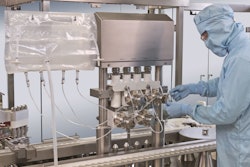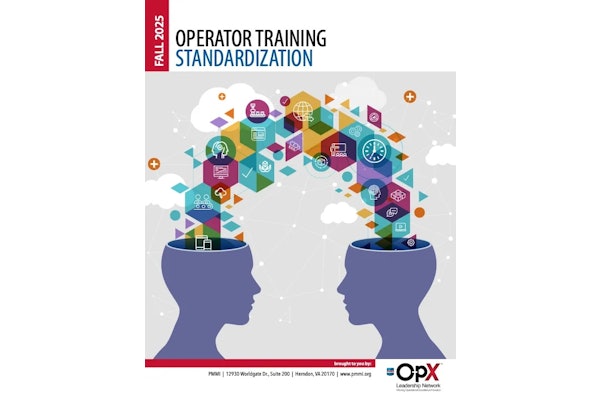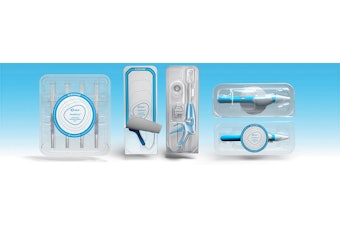Downgauging, lightweighting, and using fewer packaging materials are steps manufacturers have taken for years to cut costs where and when possible without compromising product integrity and efficacy. But sustainable business practices dive deeper than at medical device manufacturers and pharmaceutical firms.
In the pharmaceutical and medical device sectors where patient safety and regulatory compliance take precedence, manufacturers are also committing to sustainable practices, not only in material selection, but in facility management, processing, and packaging lines. And many of these manufacturers are counting on their packaging suppliers to be partners in those sustainability efforts.
Says Chris Bagozzi, manager of sterile packaging development for Medtronic Spinal and Biologics, “Medtronic is serious about sustainability. We recognize the critical interdependence between human health and the environment. Our wellbeing ultimately depends on the health and resources of the planet. For this reason, we continually strive to reduce our environmental impact. Environmental stewardship is a key pillar of corporate citizenship and provides Medtronic with a competitive advantage by satisfying our customers, reducing costs, and managing risks. Product packaging has played a major role in the company’s overall sustainability strategy.”
Enacted in Nov. 2007, Medtronic’s Environmental Sustainability Policy involves promoting energy efficiency, conserving natural resources, purchasing sustainable products, eliminating waste, reusing and recycling materials, enhancing new building construction and facility modification, and establishing environmental goals.
Medtronic sets targets
Medtronic’s goal-based sustainable efforts for the next fiscal year include 10% reductions in volatile organic compound air emissions, greenhouse gas emission and water use, and 5% reductions in regulated and nonregulated waste.
“The baseline for these goals is fiscal year 2007,” says Bagozzi. “Innovative new product packaging and literature reduction projects reduced the amount of packaging waste and paper literature by over three million pounds and saved $2.3 million. We have locations [that] have reduced millions of pounds of waste and saved over $20 million. Recently, Medtronic’s Spinal business won a sustainability award for its efforts involving cold chain shipping containers and advancements in traceability. Both efforts resulted in waste reduction.
“The cold chain shipper accomplishment was the result of switching from traditional shipping containers and materials to a more sustainable option. The business yielded a financial savings in excess of $1 million a year. The company reduced the shipper sizes, foam insulation, and the number of gel packs required for the cold chain shipments. This was in part due to collaboration with the marketing and distribution teams in determining the optimal amount of kits per shipment. Previously, the shipper was designed to accommodate space for four kits. It was determined there was a need for various shipper sizes to accommodate smaller shipments; therefore, we created 1-Kit, 2-Kit, and 3-Kit variations of the shipping configuration.”
He gives credit for the project’s success to New-Tech Packaging (www.newtechpackaging.com), which he says made the initial suggestion of using smaller shipper sizes, and also to the Medtronic Spinal packaging engineers (past and present), who contributed to the new shipper and kit designs. In the end, Medtronic was also able to reduce the labor costs, energy requirements, and packaging waste associated with shipping the product,” Bagozzi says.
Janssen/J&J goals
Philip Dahlin, senior manager of sustainability for the Janssen Pharmaceutical Companies of Johnson & Johnson relates that setting and tracking goals are important to his company’s sustainability pursuits. “We started out by focusing on ‘hot-spot’ items like PVC [polyvinyl chloride] and paper sourcing. One of our initial goals was to eliminate all PVC packaging, with the exception of primary packaging for pharmaceuticals, as there was no real viable alternative at the time for PVC blisters.
“The second goal was to ensure sustainable sourcing of fiber materials--all of our paper goods and paperboard. For these materials, we have goals of using 100-percent SFI [Sustainable Forestry Initiative] or FSC [Forest Stewardship Council]-certified content, and/or 30 percent post-consumer content.”
Dahlin says the company’s EARTHWARDS program is meant to guide development teams in all three of its sectors--Pharmaceutical, Consumer Products, and Medical Devices & Diagnostics—in developing greener products, and packaging is part of that. “Each sector designs its own packages,” he explains. “One of the big targets that we’re looking at is replacing petroleum-based polymers with bio-based polymers.”
Commenting on biopolymers, Edward Bauer, a Packaging Hall of Fame inductee, expresses concerns. “Biopolymers do not provide the performance and protection required by the products and fall far short of the requirements set by the FDA to deliver safe, efficacious products in safe packaging. Most of the materials cannot withstand relatively low temperatures and they, almost universally, are poor moisture barriers, which is the primary requirement for protecting most products. The polyalkanoates have the potential to possibly overcome this gap, although they carry for the foreseeable future a tremendous increase in cost when compared to petroleum-based polymers. The question of cost is not insignificant considering the amount of emphasis being placed upon it by the ‘unsustainable’ increase in healthcare costs.”
An anonymous respondent to Healthcare Packaging’s 2012 “Voices of Leadership” questionnaire says her company has developed global environmental packaging guides that incorporate regulations from different customers. “For each product, we calculate the weight and mass of materials going into each market. We also fill out a questionnaire that outlines what the components of each package are, what is the material, how much glue is used , the pre-consumer and post-consumer percentages, how much paper, and how much plastic. We look into each supplier to find out if they meet our requirements for heavy metals, the overall parts per million in components.”
Part of the decision-making process requires this company to take a global sustainability perspective. “We look into European Union directives for how much recycled content and heavy metals can be in the package. We have different relationships with different countries. Europe is different than the U.S.—you have to recover a lot more; a certain percentage of your package must be recovered. The sustainability group helps us fill out the forms required.”
Covidien, GSK, Smith & Nephew, HR plans
Chuck Taylor, principle packaging/manufacturing engineer at Covidien Surgical Solutions Group, says the company has set up a Packaging Sustainability Program tasked with both short- and long-term goals. “Currently,” he says, “we are looking for easy-to-implement source-reduction opportunities that will reduce the amount of packaging used by five to 10 percent, or if not able to reduce then reuse and/or recycle. For new package designs we are looking to reduce the environmental impact over previous designs by 10 percent. This will be measured using an approved and industry-accepted measurement tool. We are updating and maintaining our packaging documentation to be in compliance with national and international sustainability legislation. We will continue to elicit the voice of the customer (end user) to get feedback on how they view the packaging, their waste systems, and how we can work together to improve the process.”
Richard Adams, head of pack graphic design at GlaxoSmithKline in Raleigh-Durham, NC, says, “We have internal targets for reducing our carbon footprint and we are incentivized on exceeding those targets. A variety of solutions are employed, from reducing carton board thickness, to using less ink, to introducing ‘zero waste-to-landfill’ programs at our manufacturing sites.”
Jason Strachota, packaging development engineer II with Smith & Nephew, Inc.’s Advance Surgical Devices Div., explains, “Smith & Nephew views facilities and packaging as important opportunities to employ sustainable business practices. In packaging materials and design, we look for ways to reduce material sources, consolidate multiple package designs into one universal design, and eliminate unneeded materials wherever possible. We are approaching this in a disciplined manner using Life Cycle Analysis [LCA] to model the environmental, social, and economic outcomes of packaging design or redesign.”
Jon Wiesman, president and CEO of HR Pharmaceuticals, notes, “We are always looking to reduce our environmental footprint. We just reduced the packaging by about 20 percent and changed from a C-flute to a 24-point Kraft board that will lower our weight by an additional seven percent. This will directly reflect to our bottom line by reducing our overall shipping costs as well as our warehousing costs.”
Supplier goals
Asked if Janssen relies on suppliers more today than in years past to help meet sustainability efforts, Dahlin says, “We’ve had a whole mix of supplier engagements, all the way upstream to the polymer/resin producer level. We’ve completed scans of available bio-based materials and their potential applications. And we’re now working with our direct packaging commodity suppliers to ensure they understand our desires, and customer demands. Some of our customers in the healthcare field are starting to develop Walmart-like scorecards to evaluate the sustainability of products. Companies like Kaiser Pemanente and NGOs like Practice Green Health are starting to use scorecarding to encourage suppliers to develop greener healthcare products.
“All of our strategic suppliers are required to do a material analysis in regard to sustainability issues. They are required to analyze where their sustainability impacts are and which ones are most significant. Then they are required to determine what areas they will they focus on, and how will they measure progress. We leave it up to them, but by 2015, they need to set at least two sustainability goals, measure progress against them and report out publicly. We also encourage all of our strategic suppliers to participate in the Carbon Disclosure Project [CDP].
“To facilitate development of goals by our suppliers, we’ve developed sustainability tool kits. The response from suppliers has been positive. Sustainability is a buzzword and they’re not really sure what it means, but they want to be seen as doing something positive. So they are grateful when someone will help explain it for them and work with them to get them started. It’s helped kick off a few partnerships where we’re working with suppliers to generate mutual sustainability benefits.”
Covidien’s Taylor says his company also involves suppliers in sustainability efforts. “We are looking for source-reduction opportunities on all levels of packaging that can meet the utility and protection requirements of the system. I believe suppliers can play a large role in educating and assisting with implementation, be it through stability data and/or validation requirements.”
Bullish on sustainability
Bauer is bullish on “green” packaging, particularly for over-the-counter product packaging. He believes, “These products are more like consumer products and offer the opportunity to reduce the amount of packaging. A good example of this would be the Bayer aspirin changes of approximately two years ago. Bayer eliminated the carton and went to a bottle-only shelf presentation.”
Bauer points out the following features of the Bayer bottle, which all contribute to both a more sustainable presentation and a cost reduction:
• Bayer adopted an oval bottle that maintains the shelf dimension of the carton. This made the bottle appealing to retailers because they did not need to change their shelf sets.
• Bayer adopted a booklet-style label that provides all the information required by the government for the product, making the information available to consumers as long as they used the bottle.
• Bayer also adopted an arthritis-friendly cap that helps one of the main consumer segments for the product.
“By eliminating the carton and insert, and adopting the above changes, Bayer improved the sustainable aspects of the product and produced a package that was at minimum cost-neutral to the previous packaging,” says Bauer. “This was a win/win for the environment, consumers, and Bayer.
“Performance, product protection, and safety many times outweigh the use of biomaterials, but a system approach to design can produce a package that has more sustainable attributes than its predecessor,” he says.
Another Packaging Hall of Fame inductee, Ben Miyares, president of the Packaging Management Institute, lends a wide-reaching perspective to the issue of sustainability. He sees, “a diminishing interest in environmental sustainability, and a growing/continuing interest in economic sustainability--that is, addressing the issue as an operational/manufacturing challenge and striving for sustainability that could be defined as ‘conserving and replenishing resources.’
“This is more a matter of enlightened self-interest than a concern for the environment,” he says. “The resources pharma/medical device packagers are trying to conserve are the financial, material, personnel wherewithal needed to efficiently and cost-effectively optimize the packaging of products and the packaging process selected for that purpose.”
Excerpted from Healthcare Packaging’s February 2012, “Voices of Leadership” issue.























